Aerospace companies face competitive and congestive threats, as well as budget pressures
LONG BEACH, Calif., 2 April 2014. “While operating on all cylinders, [aerospace and defense] developers are facing new challenges – competitive and congestive threats in space and back on Earth very real budget pressures,” recognizes Mark Calassa, vice president of protected communications systems, Lockheed Martin Space Systems.
Aerospace has been through some tough times, particularly in the 1990s, but this year, in a period of less than three months, we launched three satellites, Calassa says. “How do we leverage what we learned in the past to get to where we need to be today, and not make the mistakes we made in the past?”
When it comes to national security space cost reduction, Calassa discussed several tactics. Key among them is “affordability through commonality. We are recapitalizing our satellite platforms – looking for 50 percent commonality among satellites independent of mission.”
Calassa and his colleagues at Lockheed Martin are also “using technology to reduce costs,” he says. With full lifecycle model-based engineering, everything exists in the digital domain. You can port the data to the manufacturing floor or to a subcontractor to build it. Model-based engineering is a huge cost reduction.”
Lockheed Martin is also “getting into the additive manufacturing realm,” Calassa adds. “We are actually building flight parts for that and qualifying materials to get everything we need to certify these materials. It’s a thing of the future and it’s going to come–space and defense need to get on board and lead these activities.”
Finally, “there are lots of things we can do to lean out” manufacturing and assembly processes, which positively affect cycle time, Calassa explains. “We turned the satellite on its side and build the whole satellite sideways. It’s shocking--we eliminated large percentages of processes, such as crane raises and so on.”
